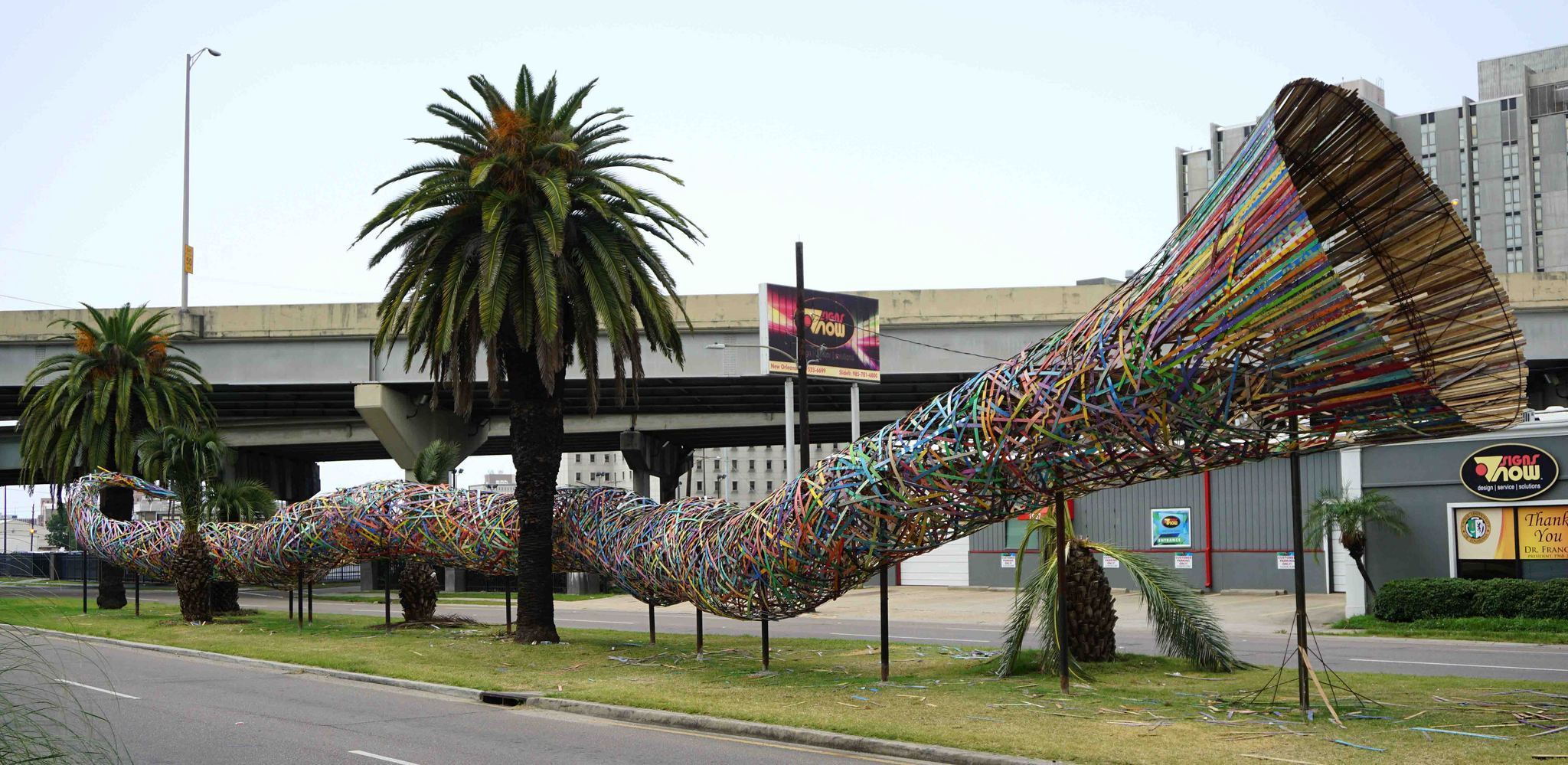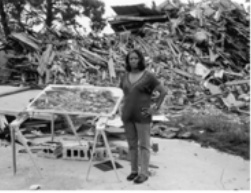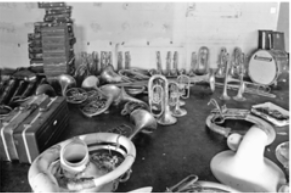
The Funnel Tunnel (Photo by: Alex Fisher)
As journalism has evolved, an alternative form of communication has become a large part of art in society. In a city as culturally rich as New Orleans, it is no surprise that one avenue of expressing the alternative in society is via public art.
An important aspect of the evolution of journalism is how it has evolved to better fit societies as a whole. Journalism is a time capsule of what is happening in the world around it, and is shaped by the people who are writing it, where it takes place, and who it is created for.
Similarly, The Funnel Tunnel, created by Patrick Renner, assembled by a team of artists and volunteers from New Orleans, and sponsored by Sculpture of New Orleans, exhibits the “alternative” as a true representation of the evolution of journalism based on the piece’s adaptation to New Orleans and installation by New Orleans residents. Moreover, the piece is sponsored by Sculpture of New Orleans, paralleling the evolution of journalism in that the installation represents what is occurring in the world around the sculpture.
This piece of alternative art ultimately sets out to brighten the streets of New Orleans and the hearts of New Orleanians after the damage done by Hurricane Katrina, and its bright colors and general street art feel definitely allow it to accomplish this goal. Therefore, the city of New Orleans’ desire to evolve from the destruction and gloom brought by Katrina also parallels the evolution of journalism to better fit society, as The Funnel Tunnel being brought to the city represents the desire to have the art reflect the optimistic, post-Katrina attitude.
At first glance, the 7,000 pound wooden and steel piece appears to be very New Orleanian—the shape is that of a horn, which, upon first inspection, feels immediately like it was designed specifically for this musical city. However, this was not always The Funnel Tunnel’s true form. The piece was originally created and displayed in Houston, surrounded by oak trees and taking the shape of a more snake-like form. However, when the piece was relocated to New Orleans, it was installed to look much more like the artistic cornucopia of culture, music, and art that was already present in the city. Because of this, the re-installation paralleled the way journalism has evolved to better fit societies as a whole, as the piece did just that when it was relocated to be among the palm trees.
Originally, pieces of journalism were distributed strictly on paper and typed with a typewriter, since our society was not as technologically advanced. Journalism soon became further developed with the introduction of the printing industry, and it has evolved and expanded even more as our society has improved technologically. Likewise, The Funnel Tunnel took a different form when it was being shown in Houston, and it evolved to fit its environment when it was brought to New Orleans. Moreover, journalism has the ability to provide a vessel to bring communities, cities, and the world together with a single source of news. Now, it is possible for everyone to convey their own message through modern journalism — through blogs, social media, and even the increased accessibility to journalism-related careers. Similarly, when Sculpture of New Orleans brought The Funnel Tunnel to the city, the organization needed the help of New Orleanian volunteers to help adapt the piece to its new home. Because of this, these people were given the opportunity to leave their own mark and showcase their own artistic expression.
The artist and the organization empowered each volunteer to have full creative control over how he or she shaped her pieces of the sculpture, designing as he or she desired. This parallels the evolution of journalism, because the sculpture served as a vessel for the people’s ideas to be mapped into and brought together as one. Renner’s piece also challenges the idea that art is meant to be strictly observed; instead, The Funnel Tunnel was created for and, in part, by its viewers.
The Funnel Tunnel delivers its message of lifting the spirits of New Orleans and its people after Hurricane Katrina, and it does so through its bright, street art feeling and inclusion of local people in its installation. After the devastating storm, the city and its people were in shambles. Lewis Watts and Eric Porter’s book New Orleans Suite: Music and Culture in Transition depicts the gloom and destruction brought by the hurricane, with photograph after photograph of ruined schools, destroyed homes, and saddened people (“Hurricane Katrina: Plates 17–43.”).


After the storm, it was only natural that this city turned to the arts to begin to rebuild its morale. The article, “It’s the Symptom, Not the Cause,” quotes Brad Pitt in an interview entitled “Saint Brad” that discussed Pitt’s role in helping to rebuild New Orleans after Katrina. Pitt remarks, “these people suffered a horrific event, and truthfully great injustice in the aftermath, and they’re still suffering that injustice. So what are you going to follow that injustice with?” (“It’s the Symptom, Not the Cause, Brad” 1). This piece follows the injustice of the devastating events of the storm not with social change, but with noteworthy brightness and positivity in the city.
The colors of The Funnel Tunnel provide a source of optimism in a city that is still very scarred from the hurricane. The Funnel Tunnel uses a street art method to create positivity, as this method is deep-rooted in New Orleans artistic and musical culture. Shaped like a horn and made of its overlapping colored paint, roadside location and on-site creation, Renner himself has linked the sculpture’s overall feeling with that of the context of the Led Zeppelin album “Physical Graffiti” (‘Funnel Tunnel’ 1).
When one thinks of the French Quarter, the first thing that comes to mind is locals playing music in the streets and all forms of artwork being created on every corner. However, all of this culture came to a halt during Katrina, so The Funnel Tunnel serves as a reminder of the street art that makes New Orleans such a unique and bright city. Likewise, journalism during Katrina reported doom and gloom, and forgot all about the positives of New Orleans. As the storm passed and journalism was able to go back to the norm, art retook its throne as a defining characteristic of the Crescent City.
Ultimately, The Funnel Tunnel serves as a method of bringing positivity back to New Orleans, and it does so through its brightness and naturally New Orleans feel. This is a remarkable piece of art, as the artist enlisted volunteers from the community to assist him, allowing him to be able to create a piece that he could not only call his own, but the community’s as well. Because of this, the members of the city could take pride in the piece, just as they take pride in being from New Orleans.
Both of these aspects of The Funnel Tunnel’s creation allow it to accomplish its goal of reunifying and restoring the city after Katrina. Moreover, just as journalism evolved over time based on the world around it, so has The Funnel Tunnel, as it was molded to fit New Orleans when it arrived in the city. Thus, many aspects of this piece of art allow it to connect with the world around it as it mimics the evolution of journalism, while also succeeding in getting its message across.
Sources:
Andrew Blum, “Saint Brad,” Metropolis, March 1, 2008, https://www.metropolismag.com/uncategorized/saint-1brad/
“Hurricane Katrina: Plates 17–43.” New Orleans Suite: Music and Culture in Transition, by Lewis Watts and Eric Porter, 1st ed., University of California Press, 2013. JSTOR, www.jstor.org/stable/10.1525/j.ctt24hsdf.8.
Lindsey, Cathy, et al. “Led Zeppelin Physical Graffiti Building In Color by Randy Aveille.” Fine Art America, fineartamerica.com/featured/led-zeppelin-physical-graffiti-building-in- color-randy-aveille.html.
.
 NOLAbeings Multimedia artist Claire Bangser created NOLAbeings as a portrait-based story project that marries...
NOLAbeings Multimedia artist Claire Bangser created NOLAbeings as a portrait-based story project that marries...  Voodoo in New Orleans: Reviving history: New Orleans fortune telling This article takes a deep dive into the history of Voodoo in New Orleans, its hybridization with Catholicism, and its present-day place in the city's culture. The author visits fortune-tellers in the French Quarter, using their guidance as a tool for introspection rather than a deterministic predictor of the future. Through her experiences in New Orleans, the author feels a mystical connection to both the past and the future.
Voodoo in New Orleans: Reviving history: New Orleans fortune telling This article takes a deep dive into the history of Voodoo in New Orleans, its hybridization with Catholicism, and its present-day place in the city's culture. The author visits fortune-tellers in the French Quarter, using their guidance as a tool for introspection rather than a deterministic predictor of the future. Through her experiences in New Orleans, the author feels a mystical connection to both the past and the future. 